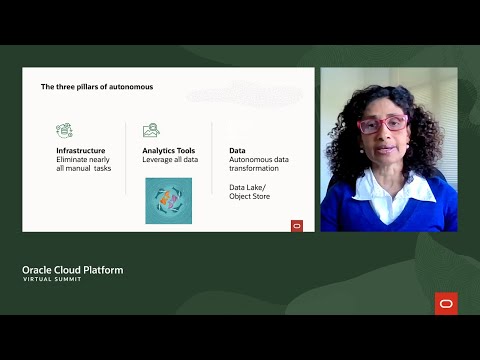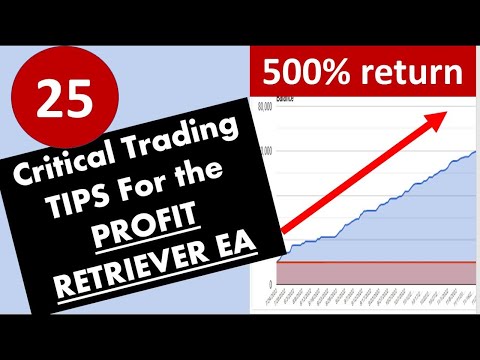Achieving the promise of self service for the line of business

JANET GEORGE: Hi, I'm Janet George, GVP of Autonomous in Oracle. One interesting fact about me is that I am a trained computer scientist. Prior to Oracle, I had the privilege of working in a few tech giants like Apple, eBay, and Yahoo.
Back in Yahoo based, Hadoop was invented and operationalized along with distributed computing and early cloud technologies in my team. The last six years, I served in Western Digital as a fellow and chief data officer for this manufacturing company, taking them through an autonomous transformational journey powered by AI and machine learning. Think lights-off cognitive automation in the factories driving top-line revenue growth. If a manufacturing company is not immune to the disruptive power of autonomous, no other industry sector is. Let's talk about autonomous.
The word is autonomous, and the word has been autonomous for the last eight years. This trend is here to stay. So now, as we think about autonomous, what makes an autonomous enterprise? An autonomous enterprise is an enterprise that has really tackled three pillars very effectively.
The first pillar is really modern infrastructure. They have managed to take on and massively adopt cloud and modded distributed computing infrastructures, seamlessly able to scale through using these modern infrastructures. The second pillar that they have tackled really well is modern tools, AI, machine learning, and other technologies, and the third pillar is the data, their most strategic asset that they can then tap into to convert into knowledge and insights that will drive their top-line revenue growth. OK, so why autonomous? When you think about autonomous, autonomous is a prerequisite foundation for data-driven culture. One has to extract maximum value from the data while solving for business outcomes, and autonomous enterprises have figured out how to make their data extremely fluid as it moves through the organization. So they have solved the data mobility problem.
Now, autonomous enterprises are powered by machine learning and AI. These organizations know how to unlock the hidden value of their data. Now, Oracle self-service applications allows everyone to unlock value from their data by deploying machine learning algorithms. Now let's look at our customers. Our customers are becoming autonomous.
They're all on autonomous journeys. And how do we know this? Because there's massive disruption happening in the industry, and our customers are right in the middle of that disruption. They have tried to figure out what to do with their data. Their data is locked in silos, and they're trying to get rid of these silos and move the data out of the silos. This is a very natural, manual, tedious process, but they want to be able to tackle their data and look at security and governance.
They want to look at data integration. They want to look at the data quality, and then finally, they want to get insights from that data. So our customers are really trying to figure out how not to be plagued by silos when they are faced with such a disruption.
Now, having data silos is quite normal. If you look at most of our customers, many of them, 80% of them, have data silos, and then many of them, 67%, have shadow repositories. There is no single customer view that they can extract, so they have to overcome this by trying to figure out how to break that gridlock of data silos. Now, one trend we are seeing in the market is-- I call it a critical trend.
A critical trend we are seeing is the hiring of chief data officers and chief scientific officers. Now, this trend is on the rise. In fact, hiring chief data officers have quadrupled in the last couple of years, and what we found is that the chief data officer has been swept into the C-suite just because the amount of data that organizations are creating and being tapping into have made it very, very significant, higher. And it's on the rise. Now let's look at what this chief data officers are charted with.
They're actually chartered with reimagining the business. They're chartered with building data-driven foundations. The main goal is to figure out how to provide seamless data access to everybody within the organization, ability to enable all data types, structured data, unstructured data, all the different schemas, trying to figure out how these schemas can talk to each other, and finally, self-service enablement. They want the organization to be able to look at the data without having to write very long, extensive data queries.
Now, when you think about outcomes, most organizations want to tap into their data to really solve for outcomes. So when you're thinking outcomes, you're thinking, how quickly can I get to the outcome, the role of self-service in trying to get to the outcome. So the data is in silos. You want to extract the data out of the silos. You want to apply machine learning techniques, and you want to get to that knowledge.
And the ability to do self-service to get to that knowledge quickly saves you time, and energy, and speed. So what we want to do is, again, see how Oracle can help you with the self-service enablement and innovation. So I'm going to share with you one example of how we can do this. In order to be successful, the businesses must have access to comprehensive self-service analytical environments so they're not reliant on IT.
They need to be able to work with all the data. They need to be able to test the hypothesis. They need to be able to use different kinds of analytics or machine learning and ultimately find ways to keep ahead of the competition. So what I want to do now is to hand this over to my colleague, Sam, who will show you what that looks like. He's going to take you through a scenario about a movie streaming company whose executives are worried about customer churn. And if you're worried about customer churn, then this is something that the company would want to investigate very quickly.
So Sam, if you can show us how this could be done. Thanks for the introduction, Janet. My name is Sam Heinrich.
I'm an Associate Consultant in the Strategy and Transformations organization here at Oracle. Today, I'm going to be taking you through how Oracle self-service applications can help a business analyst solve a complex data problem. In this case, we've got a movie streaming company who's worried about losing customers.
Now, as you can see, we have about 1,800 lost customers, which represents 1% of our customer base. So clearly, this is a big problem, and they've lost these customers in the last month. I'm looking at our corporate dashboard which shows some of the general information we have about our lost customers. Now, I want to define exactly what I mean by a lost customer or, as I may refer to it going forward, churned customers. As you can see, these customers made purchases in each of September, October, and November of 2020, but all but one of them did not make any purchases in December of 2020. So this is going to be the definition we'll use going forward.
Purchases were made in September, October, and November, but none were made in December. Now, I want to create a way to predict customer churn, so I want to know how can we prevent it. And the way I'm going to do that is by getting more data and by implementing a machine learning model.
Let's start by loading the data from our corporate data lake. So here I am in the data lake, and I want to add as much information as I can about our customers. So I'll go to Data Load, and I'm going to pull from our Autonomous Data Warehouse.
So I'll go to Cloud Storage, and here is all the data we have in our corporate data lake. I'm going to pull CustSales because this contains all of the transactions and all of our information we have about our customers, so this will allow us to predict whether a customer will churn or not. It would take a little too long for me to load for this demo, so I'm going to go ahead and look at the data transformations we'll need to do to get this ready for a machine learning algorithm. So as you can see, we need to do some complex transformations, but Oracle's Data Integrator makes this easy.
There's one less that to do, and I've done everything else so that this is quick for the demo. But what we need to do is replace our null values. So the data as we have it has some blank values, and we want to turn those into zeros. So I'll go here, to Data Preparation, and I'll add a data cleansing step.
I'll drag this here, and I want to rename this ReplaceNull. Now, I want to do this for all of the columns in all of our data sets, and I want to replace null numeric fields with a zero. Now that I've chosen that, I can drag it here, and I would then save it and go ahead and run it. It would take a few seconds too long for a demo, so I'm going to jump ahead to where we've built our machine learning algorithms. So Oracle machine learning-- machine learning is typically the field of the data scientists.
A problem like this might require multiple calls to IT to make sure we're transforming the data correctly, and then once we actually get to the machine learning, we would need a whole team of data scientists. Oracle machine learning allows business analysts to do complex machine learning experiments with just a few clicks. So I can see the steps that AutoML took in order to create these models, such as algorithm selection, adaptive sampling, and feature selection, and I can see the results of the experiment. So we've got a list of all the models that AutoML tried and their accuracy. So we can see that the best was the neural network, which had over 90% accuracy, and if we click, we can see which of the features from our data set were the most impactful in determining whether we thought we would lose a customer.
Now, I can also use a confusion matrix to better assess the model accuracy. So here we can see that of the 20 actually lost customers, our algorithm correctly predicted 19 of them, and although there were a number of false positives, that's OK because we're going to use this data to try to offer some sort of promotion to the customers we think might stop using the service. So if we offer the promotion to a few too many, that's a lot better than not offering it to people who will actually end up stopping using the service. Now, if I had a data scientist who wanted to fine-tune the machine learning algorithm or just better understand exactly what the algorithm did, I can click Create Notebook, and that will generate all the code so that a data scientist can easily fine-tune or customize it to their needs. Now that I have my model, it might be good to enhance it in the future, and we could do that using graph analytics.
Here we see a chart of whether customers read other customers' reviews of our service and how that might have influenced their purchasing behavior. So with this, we could easily add it to a machine learning algorithm and enhance our findings. But I'm going to work with the model we have already set, and I want to figure out how we can use this to actually offer a promotion and try to keep some of the customers we lost. So here we see a map of the customers that the model has identified might be likely to stop using our streaming service.
It is also color-coated based on their proximity to a nearby pizza restaurant. So what we can do is we can offer a promotion where the customer receives a discount at the pizza restaurant if they purchase a movie using our streaming service, and hopefully this would entice customers to continue watching movies when they otherwise might not. So now I've taken you through an example where a business analyst can use Oracle's self-service applications in order to create real business insights using machine learning and data transformations without having to call IT or write complex code. JANET GEORGE: Thank you, Sam. I got two takeaways from that demonstration.
First, if you or your colleagues are in the line of business-- and this is something you should take a look at. It's not just self-service analytics, but actually, it's a whole self-service analytical data warehouse, everything the line of business needs to solve problems and to do so without having to call IT for help. My second key takeaway is, if you are in IT, then this is a data warehouse environment that you want your line of businesses to be using. It has everything you need to get that done, and it's very self-reliant.
So you can spend time looking at the analytics and let your business not have to deal with data loading and data transformations. You can do that for them, and you can do the analytics for your business. Now let us take a customer example and look at how we engaged with the customer because I know not all of you want to do self-service. You might want some help.
You may not be fluent with machine learning or analytics, and if you want help, then I will demonstrate how we can do that by engaging with Oracle. One of the big strategic customers approached us, and they wanted us to help them with the self-service analytics. So basically, what they told us is, we have a top-line business strategic use case that we want to solve for. And so we went into a discovery process with our client, and we tried to understand what they wanted us to do. Through the discovery process, we learned that they had a very limited understanding of their customers, and they wanted to better understand their customer segments. And they wanted to do this by member clustering.
And then they wanted to market basket analysis, what their customers are actually buying and what products influenced the purchase of other products so they could get top-line revenue. And so our customers went through a framework that we engaged with, and we engaged with the C-suite of our customer base. And so we defined the problem. We looked at what they wanted to solve. We talked about an approach. We understood the outcomes that they wanted to solve for, and then we went into the analysis.
So as part of the analysis, we were able to do customer segmentation, and the outcome-- when we started out on the customer segmentation, we used a multi-dimensional approach. So initially, the customers were looking at their customers just on one dimension, how much money are they spending on our site and what transactions they're doing. But as we started to engage with them, we learned that we could do a multi-dimensional approach. And so we used three dimensions to look at clustering of their customers.
The first dimension was really looking at the transaction, just as they had been doing. The second dimension was to really look at the frequency of the purchase, and then the third dimension was to really look at how recently they purchased. So using these three dimensions, we started to segment their customers, and then we got to the outcome, the C-suite was really flabbergasted. They were like, wow.
Literally, of the one billion customers they had, more than 50% of those customers were low-revenue-contributing customers. In fact, pretty much 90% of the revenue was generated by less than 30% of their customers, huge eye-opener. So the C-suite felt like they were running their business kind of blindly. They did not have a really good understanding of their customers on multiple dimensions, and they were spending money marketing cost to really figure out how to market to these customers without having a clear understanding of how the customers were spending time or money on their website.
Next, they wanted us to do market basket analysis, which means, when a customer walks into the store in the retail, what are they buying? What are the purchase behavior patterns? What are the correlations between the purchase behaviors? Are they buying beer with beer? What else are they buying? Are they buying candy? Are they buying cigarettes? What do these purchase behaviors look like? And they wanted to have an understanding of how these purchases are made. Are they made sequentially? Are they made based on the season? Are they made based on item numbers, and what are some of the correlations? So we were able to deploy graph analytics, and through graph analytics, we were able to classify top five categories which were key product influences to product purchases, so cigarettes, fuel, soda, sweets, and pastries bubbled up to the top nodes of the graph and became the top products that influenced key purchases. So graph and market basket analysis were the two outcomes we solved for one of our big customers using our Oracle analytics capabilities and our Oracle Analytics stack. So Oracle has a full stack of products that we offer to our customers for the enterprise, and so we have data engineering. We allow your data to flow through batch or streaming.
We have data management products, and so we allow you to manage your data through your data warehouse or through your data lake. We have data analytics products so you can do analytics or you can do data science through our data science platform, and we also allow you to do visualization on our stack. So Oracle has the complete stack for all customers that are on this autonomous journey. Let me conclude by sharing with you three to four key takeaways. When we are on an autonomous journey, when our clients are on an autonomous journey, they want to tap into fully-autonomous capabilities. Fully-autonomous capabilities allows for limitless scale.
That means no over-provisioning or not under-provisioning of your clusters, no bursting of capacity. You're able to grow to your demand in workload seamlessly. So your second key takeaway is autonomy allows for 99.5% availability through redundant architectures. That means you can actually future-proof your architecture, and you can move from architectural rigidity to operational agility.
And number three is your data access. So autonomous allows you to have data access, which means you can go through your data provisioning. You can go through your data processing you can go through your data persistence, and you can go through your data transformation all autonomously. Next key takeaway is autonomous security, and this is a very important one because you don't want downtime on your clusters. You want self-patching.
It saves you time. It saves you energy, and most importantly, it saves you a lot of patching human errors that occur from manual patching for every new security patch that is released out in the market. And the last takeaway I will say is cloud computing allows you managing complexity-- allows you to manage complexity.
And when you look at distributed computing, you're looking at quadratic levels of complexity. Now, Oracle does all this for you. Oracle has the technology to allow you to manage distributed computing and cloud computing complexity.
Thank you.
2021-04-19 20:30


